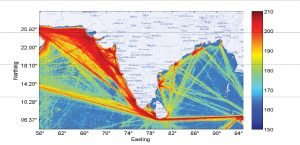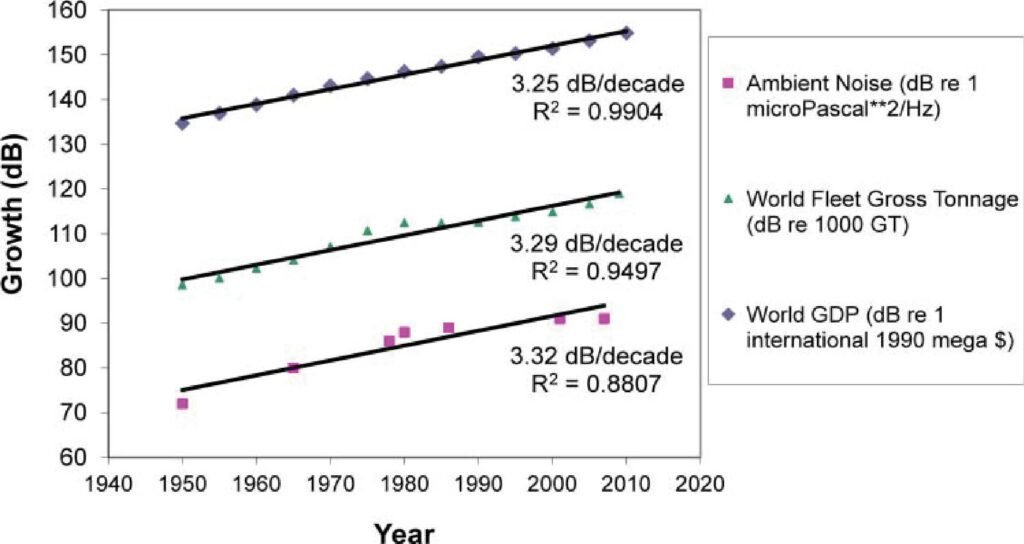Any alterations to the acoustic environment will have significant impact on the marine mammals’ long-term well-being. This is referred to as acoustic habitat degradation.
The global community celebrated the World Maritime Day recently on 29 September. The purpose of the World Maritime Day is to appreciate the importance of maritime industry and to underline the importance of maritime security, maritime environment, safety, and shipping. The day also marks the day of adaptation of International Maritime Organisation (IMO) convention in 1958 under the United Nations. The importance of the maritime industry and more specifically the shipping, requires no emphasis. The shipping industry is so tightly linked to growth engines of the global economy that any reforms become a political issue.
The term “Noiseonomics” has been coined by G.V. Frisk to describe the relationship between ambient noise levels in the sea and global economic trends. The growing awareness among the stakeholders of the marine eco-concerns have attracted significant attention on the topic of noise in the oceans and its impact on the marine mammals from the scientific community and the general public. The two primary concerns brought out by Frisk are:
A: What are the historical changes in ambient noise levels over decadal time scales, and can reliable predictions be made of future changes in noise levels for the decades to come?
B: What is the impact of a changing acoustic environment on the behaviour of marine mammals, since they rely so heavily on acoustics as a primary means of communicating, navigating, and foraging in the marine environment?
Marine mammals are known to depend on acoustic signals to perceive the environment around them and thus, any alterations to the acoustic environment will have significant impact on their long-term well-being. This is referred to as Acoustic habitat Degradation. The low frequency ambient noise levels in the open ocean have been reported to have increased to the tune of 3.3 dB per decade during the period 1950-2007. The work by Frisk attributes this increase in ambient noise levels in the ocean primarily to commercial shipping activity that is considered the main driver of global economic growth. As a corollary, they conclude that ambient noise levels are directly linked to the global economic conditions and propose models to predict future ambient noise levels based on global economic trends. Figure 1 presents the results of the extensive research undertaken by G.V. Frisk. The trends shown in Figure 1 are alarming and serious efforts are required to manage the low frequency underwater noise due to shipping.
Although late, but the IMO has now taken up the issue of underwater noise very seriously in the recent times and there are multiple nations and their researchers pushing their noise mitigation strategies and products at an aggressive pace. As usual, crisis is also an opportunity and, thus, there is hectic activity to grab such an unimaginable opportunity. However, a critical appreciation of the larger dimension of the crisis is yet to be achieved. The West driven global order always misses the requirements of the rest of the world and always tries to push their agenda. The new global order is now demanding a much more inclusive approach.
The issue of underwater noise needs to be seen from a source-path-receiver model. The source is the radiated noise from the ships that is the single ubiquitous noise source in the low frequency band. The distribution of shipping traffic across the world with the low frequency noise suffering least attenuation in the underwater medium is another cause of concern from the sustainability angle. The impact of the low frequency shipping noise is observed thousands of kilometers from the source. The lack of regulatory provision for noise-control measures at source is a serious limitation. Although acoustic stealth onboard naval platforms have been a significant requirement and high investments have happened to manage the issue, it has remained classified with the developed west as a military secret. Thus, the cost of noise control has been prohibitive for the rest of the global community and now there is an attempt by the developed-west to recover their investment.

The path is the modification to the radiated noise at source, while propagating through the underwater medium. The tropical waters are known to have maximum impact as far as the underwater medium is concerned and the research community globally has least understood the tropical conditions. The underwater research that was largely undertaken during the Cold War period was focused in the temperate/polar waters of the Greenland-Iceland-United Kingdom (GIUK) gap. The distortions on the radiated noise at source in the tropical waters is of the order of 60 % and thus the impact analysis at the receiver cannot ignore the path related propagation distortions. The Indo-Pacific region space today is witnessing maximum strategic interactions and more and more global players are maintaining their maritime assets in the region. The entire shipping traffic of the world passes through this region. The Indo-Pacific strategic space is defined as the tropical waters of the Indian and the Pacific Ocean. So how can we ignore the impact of the tropical waters, just because the west does not understand the unique characteristics of the tropical waters? More simply put, it is economically unviable for the west to invest in the local site-specific R&D that is inescapable in the tropical waters. The most important requirement here is that the nations in the tropical region need not adhere to the standards formalized for the temperate/polar region and can seek concessions. The developing world in the Indo-Pacific region, based on their socio-economic conditions will require some more time to achieve the standards set by the West.
The receiver translates to the vulnerable species that will finally be impacted by the underwater noise. The impact of the acoustic habitat degradation needs to be quantitatively and qualitatively assessed, before any attempt is made to regulate the entire space. The entire spectrum of species, given the rich biodiversity in the tropical waters, need to be analyzed for their unique perception of acoustic signal. A generic extrapolation of the noise impact based on studies done by the researchers in the west will have least relevance in the tropical waters.
The Maritime Research Center (MRC), Pune has developed a digital tool to provide a spatio-temporal real-time low frequency ambient noise map based on the Automatic Identification System (AIS) data of the shipping traffic. Figure 2 represents the low frequency ambient noise in the Indian Ocean Region (IOR), however the tool can generate similar maps across the entire world, if the AIS and the underwater medium parameters are provided real-time. The tool provides a qualitative and quantitative analysis of the acoustic habitat degradation, with a comprehensive source-path-receiver appreciation in the tropical waters. Such assessment will go a long way in bringing well informed policy & technology intervention to manage the Sustainable Development Goals (SDG-14). This being the United Nations (UN) declared Decade of the Ocean Sciences for Sustainable Development, such digital transformation will be fundamental shift into the new global order.

The path is the modification to the radiated noise at source, while propagating through the underwater medium. The tropical waters are known to have maximum impact as far as the underwater medium is concerned and the research community globally has least understood the tropical conditions. The underwater research that was largely undertaken during the Cold War period was focused in the temperate/polar waters of the Greenland-Iceland-United Kingdom (GIUK) gap. The distortions on the radiated noise at source in the tropical waters is of the order of 60 % and thus the impact analysis at the receiver cannot ignore the path related propagation distortions. The Indo-Pacific region space today is witnessing maximum strategic interactions and more and more global players are maintaining their maritime assets in the region. The entire shipping traffic of the world passes through this region. The Indo-Pacific strategic space is defined as the tropical waters of the Indian and the Pacific Ocean. So how can we ignore the impact of the tropical waters, just because the west does not understand the unique characteristics of the tropical waters? More simply put, it is economically unviable for the west to invest in the local site-specific R&D that is inescapable in the tropical waters. The most important requirement here is that the nations in the tropical region need not adhere to the standards formalized for the temperate/polar region and can seek concessions. The developing world in the Indo-Pacific region, based on their socio-economic conditions will require some more time to achieve the standards set by the West.
The receiver translates to the vulnerable species that will finally be impacted by the underwater noise. The impact of the acoustic habitat degradation needs to be quantitatively and qualitatively assessed, before any attempt is made to regulate the entire space. The entire spectrum of species, given the rich biodiversity in the tropical waters, need to be analyzed for their unique perception of acoustic signal. A generic extrapolation of the noise impact based on studies done by the researchers in the west will have least relevance in the tropical waters.
The Maritime Research Center (MRC), Pune has developed a digital tool to provide a spatio-temporal real-time low frequency ambient noise map based on the Automatic Identification System (AIS) data of the shipping traffic. Figure 2 represents the low frequency ambient noise in the Indian Ocean Region (IOR), however the tool can generate similar maps across the entire world, if the AIS and the underwater medium parameters are provided real-time. The tool provides a qualitative and quantitative analysis of the acoustic habitat degradation, with a comprehensive source-path-receiver appreciation in the tropical waters. Such assessment will go a long way in bringing well informed policy & technology intervention to manage the Sustainable Development Goals (SDG-14). This being the United Nations (UN) declared Decade of the Ocean Sciences for Sustainable Development, such digital transformation will be fundamental shift into the new global order.



Leave a Reply